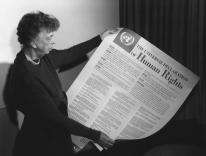Last year was an eventful one for queer people in the Orthodox Church. After Russia invaded Ukraine last February, we were summarily drafted into Putin’s narrative of the invasion by Patriarch Kirill, head of the Russian Orthodox Church. In a shocking sermon (ironically delivered on the Sunday of Forgiveness Vespers marking the start of Orthodox Great Lent), Kirill cited the prevalence of gay pride parades outside Russia as the defining symbol of the West’s slide into unrepentant sin. Western decadence and tolerance for homosexuality thus justified Putin’s violent incursion into Ukraine.
Kirill’s reactionary remarks were followed a few months later by a more encouraging gesture from Orthodox officials. On a visit to Greece in July, Archbishop Elpidophoros, head of the Greek Orthodox Archdiocese of America (GOARCH), visited the Athenian suburb of Glyfada and baptized the two children of Peter Dundas and Evangelo Bousis (a luxury fashion designer and actor, respectively). Photos of the gay couple with Elpidophoros circulated widely online; some heralded them as a sign of progress in the Greek Orthodox Church. (Similarly, Elpidophoros had also appeared in photos alongside Black Lives Matter protesters in New York after the murder of George Floyd in 2020.) Others worried that the baptism was merely a photo-op, not part of any concrete plan for pro-LGBT institutional change.
Weeks later, hierarchs of the Orthodox Church in America (OCA), a self-governing North American jurisdiction distinct from both the Russian Orthodox Church and GOARCH, released a “Statement on same-sex relationships and sexual identity” at their biennial conference in Baltimore. The document recapitulates the historical stance of the OCA on marriage and sexuality: marriage is limited to one man and one woman. For those “who suffer from the passion of same-sex attraction,” the statement enjoins “a life of steadfast chastity and repentance”—a tired claim that lazily fails to articulate a positive vision for how LGBT people should lead their lives. The statement’s conclusion prohibits any OCA member from contradicting the synod’s teachings on sexuality in any form, to any degree, under threat of immediate discipline.
These episodes reveal a disturbing pattern in Orthodox-LGBT relations around the world. Even in the Church’s tentatively progressive moments, LGBT people are largely not permitted to speak for ourselves. We can neither verify nor contest the accuracy of the claims made about us, and we have no say in what our lives in the Church should look like. At best we are relegated to the status of passive onlookers; at worst we are scapegoats for everything hierarchs find wrong with the world today.
Perhaps that is beginning to change. Orthodox Tradition and Human Sexuality, a new volume edited by Thomas Arentzen, Ashley M. Purpura, and Aristotle Papanikolaou, fills a void in Orthodox theological literature on queer sexualities. Since 2005, the standard book on the topic in English was Fr. Thomas Hopko’s Christian Faith and Same Sex Attraction: Eastern Orthodox Reflections. That book encouragingly affirmed the dignity of LGBT people, but failed to reckon with the unique challenges we face. (To its credit, it did not recommend conversion therapy.) Another 2017 volume, “For I Am Wonderfully Made”: Texts on Eastern Orthodoxy and LGBT Inclusion covered more diverse territory but was written primarily by straight and cisgender contributors.
Arentzen and Purpura’s introduction to Orthodox Tradition quickly summarizes the state of sexuality and gender studies from the perspectives of both queer theory and Orthodox theology. The editors then pose a series of questions: “How can the Church address its own shortcomings and build a new trust? How can the Church meaningfully minister to people of sexual minorities?… What resources—albeit underdeveloped—for dealing with issues of gender and sexuality does the Orthodox Tradition feature?”
This is a reassuring passage, suggesting that the authors have grasped the scope of the problem. But it also invites the reader to hold the book accountable. The editors invoke the metaphor of the agora: the volume’s task, they write, is “not to conclude a discussion, but to begin it.” Orthodox leaders will find it an aid to ministering “with greater pastoral awareness, compassionate courage, and theological empathy.”
Though it can sometimes feel as if the authors (a mix of historians, scientists, political theorists, pastors, and theologians) are talking at cross purposes, Orthodox Tradition largely succeeds in its goals. In “Something New Under the Sun: Sexualities, Same-Sex Relationships, and Orthodoxy,” Bryce E. Rich uses insights from Michel Foucault and David Halperin to outline the philological complexities underlying Scriptural presentations of sexuality. Ekaterini Tsalampouni’s “Biblical Tradition and Same-Sex Relations” further cautions against straightforward appeals to Scriptural authority when it comes to homosexuality. Unlike some other Christian traditions, Orthodox hermeneutics view Scripture as a “vital and integral part” but “not as an independent and self-sufficient authority distinct from the rest of Church tradition.” Just as importantly, she notes that while “biblical text remains normative,” it does so only “through its appropriation by its interpretive community.” The implication is that the Church may rightfully revisit its traditional interpretations of Scripture in light of emerging information, novel historical circumstances, and changing intellectual paradigms.
Several other authors do just that. Aristotle Papanikolaou’s “A Theology of Sex” is characteristically adventurous, putting Alasdair MacIntyre’s work on virtue ethics in conversation with Maximus the Confessor’s writings on eros and theosis. Papanikolau elaborates an ascetic, homoerotic sexual ethics that creatively circumvents many of the standard ecclesial arguments against LGBT inclusion—as well as some of the most common arguments for it. Working in a slightly different register, Spyridoula Athanasopoulou-Kypriou follows in the footsteps of Anglican theologian Sarah Coakley by using Gregory of Nyssa’s insights on virginity, sexuality, and the soul’s ascent to God to invite the Church to “change our perspective when judging human relationships.” It should not focus on “the sex of those who are in a relationship,” but rather on “how they relate to each other, to the rest of the creation, and to God.”
There are a few notable omissions. What about queer people who believe they are not called to sexually active relationships? Or the mental health challenges that beset LGBT people at higher rates than the rest of the population? I would have liked to read an intersectional analysis showing how sexuality is just one area in which people suffer oppression. Fr. Richard René’s contribution describes his experience as a prison minister who meets a transgender woman named Michelle. She had been sentenced for a rape and murder committed before her transition. To his credit, Fr. René affirms Michelle’s gender identity and pronouns, and offers a thorough theological account of why he does so. But missing from his essay is a comparably detailed reckoning with Michelle’s status as an incarcerated person, the role of prison in her life, and Fr. René’s problematic role as a prison chaplain.
So much writing about LGBT people and Christianity has been done with different heuristics than those employed by Orthodox Christians. Orthodox Tradition will be a welcome read both for Orthodox craving more on the subject from within their tradition, and from those outside of Orthodoxy interested who want another perspective. As a queer Orthodox Christian, though, I finished the book wanting more. What good do the voices of a small group of academics and priests agreeing that “yes, things should be better for LGBT people in the Church somehow, someday,” do in the face of one of the most powerful Orthodox leaders openly justifying an illegal war with homophobia?
Arentzen and Purpura are consoled by the fact that recent years have seen an encouraging turn toward dialogue between Orthodox theologians, ministers, and LGBT people. I don’t have anything against dialogue, but what’s really needed—especially in the face of entrenched homo- and transphobia—is solidarity. Here’s hoping the tentative discussions taking place in lecture halls will continue to include more LGBT people, from more walks of life, so that we can build a more supportive, accepting church together.
Orthodox Tradition and Human Sexuality
Ed. Thomas Arentzen, Ashley M. Purpura, and Aristotle Papanikolaou
Fordham University Press
$40 | 352 pp.
Please email comments to [email protected] and join the conversation on our Facebook page.
Previous Story
The Revolution of the Passion
Next Story
You Can’t Earn Easter


